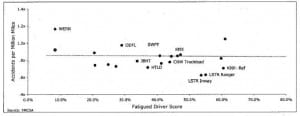My wife’s parents were killed by a drunk truck driver when she was just 12 years old. I’m in favor of just about any rule that makes our roads safer. On January 6th, 2020 motor carriers will be required to begin using the Drug and Alcohol Clearinghouse to screen for drivers who are ineligible to operate a commercial motor vehicle based on failing a Department of Transportation (DOT) drug and alcohol test.

Drivers are required to take a preemployment drug and alcohol screening test. Drivers are then subject to random tests, which are usually given on a monthly basis. This regulation is designed to make our roads safer.
But there has been a glaring loophole. A driver could fail a drug and alcohol test and then just mosey down the street and get a job with a different trucking firm. There was no mechanism to know that someone had failed the preemployment drug and alcohol test.
DriverReach, a Driver Recruiting Management System firm, has published a downloadable book on this topic. In the article that follows, I’ll summarize some of the main points from the book and the Federal Motor Carrier Safety Administration’s (FMCSA) website on this new regulation.
- The industry has been in favor of this regulation for a long time. Crashes that are judged to be the fault of a trucking firm can result in large judgements in law suits, fines, and higher insurance costs. “The trucking industry began calling on the federal government to create a central database, or clearinghouse, that catalogs the drug testing history of CMV drivers” more than 20 years ago. Finally, several pieces of legislations and a rulemaking later, the trucking industry is poised to get the regulation they have been asking for.
- The clearinghouse will collect not just all the instances where drivers test positive on drug or alcohol tests, but also refusals to take the test, and actual knowledge that a driver was driving impaired. The drugs tested for include marijuana, cocaine, opiates – opium and codeine derivatives, amphetamines and methamphetamines, and phencyclidine – PCP. A driver fails the alcohol test if the alcohol concentration is 0.04 or greater.
- Carriers will be required to query this central database as part of the hiring process. Further, on an annual basis, motor carriers will need to request a “limited query” of all their CDL drivers. “This ‘limited query’ tells the carrier if any information exists in the clearinghouse on the driver. If information exists, carriers will have 24 hours to request a ‘full query’ and review the information to determine if the driver is eligible to operate a CMV.”
- The law impacts an ecosystem that is bigger than just the drivers and the carriers. It affects the firms trucking companies hire to find drivers and all parties involved in drug and alcohol testing process such as medical review officers or substance abuse professionals.
- FMCSA, like all government agencies, is required to do an economic analysis before changing their regulations. FMCSA estimates the new rules will eliminate almost 900 crashes annually. After subtracting out the added regulatory costs, the new regulation will result in a total net benefit to society of approximately $196 million.
- There is a return-to-duty process. Drivers are not banned permanently from driving. The process begins with a face-to-face substance abuse evaluation conducted by a substance abuse professional that has met the required credentials mandated by the Department of Transportation. The professional makes treatment and education recommendations for the employee. Once the employee has successfully complied with the recommendations, a follow-up face-to-face evaluation is scheduled with the same professional. Based upon the follow-up evaluation, a written determination of the employee’s eligibility (or ineligibility) to perform the job is issued. The employee must then pass the drug tests. The trucking firm is not required to return the employee to work.
This new rule seems obvious to me. It is shocking that it took twenty years to get this regulation on the books.




















